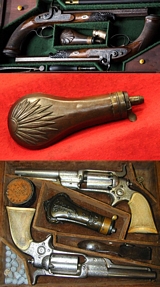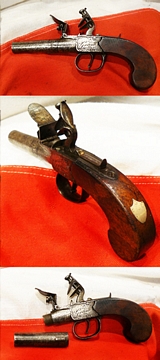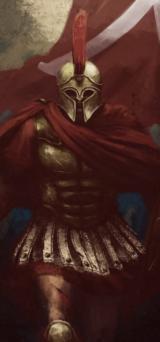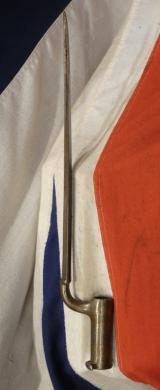Antique Arms & Militaria
A Superb Case Hardened Steel Gun Lock Of a Greene Carbine 1856 For the Crimean War Then the American Civil War
Scarce British-Type Greene Carbine by Massachusetts Arms Company
Case-hardened swivel breech action with Maynard tape primer system. Lock marked: Queen's crown /VR/Mass.Arms Co./U.S.A./1856.
James Durell Greene was a prolific firearms inventor and determined to make his mark This carbine lock was manufactured by the Massachusetts Arms Company and exported to Great Britain after being inspected and stamped with the Queen's Crown by British inspectors in the USA. These were used by the British Cavalry in the Crimean War but re-exported to the USA after the Crimea War. These fine guns were deemed to be very accurate but the paper and linen cartridges of the time were criticised as being prone to swell in the damp and consequently the carbine did not find favour with the British Government. The carbine features an unusual "floating thimble" to obdurate the breech and an internal "pricker" that punctured the cartridge. It also featured Maynard Tape priming which was in the forefront of priming technology at the time and the mechanism for this is in perfect condition. The quality of workmanship is exceptional and it actions as crisply today as it did when it was made 158 years ago.
An exceptional item in outstanding condition. Only 2000 were manufactured and a complete carbine sold at Rock Island auction for $6,900 in 2021 read more
395.00 GBP
A Very Good & Highly Desirable, 19th Century Pistol Powder Flask For Cased Duellers or Revolver
The most desirable kind of antique powder flask. The large fowling piece flasks can be very inexpensive, but the small 'cased pistol' sized flasks are incredibly sought after, as they can fit into cases were the flask is missing beautifully and complete a cased set perfectly..
A very good flask with crescent and bush embossed design, good spring and nice patination. All good seams. A great find for those that have a cased revolver single or pair or a pair of cased duellers lacking their flask. We show several cased pistols all with similar sized pistol flasks, including a cased pair of Colt pocket revolvers, and a pair of Durs Egg duellers.The flask is 4.75 inches long overall, max width 2 inches. read more
295.00 GBP
A Wonderful Victorian Dandy Cane, With the Head of an Expressive Monkey
The monkey's head is made of simulated amber, with decorated highlights. It conveys a somewhat wry expression. Monkeys have created a fascination in British art, design sculpture for over two centuries and their depiction in walking or dandy canes is nothing but a delight. This is an especially endearing large example. The cane haft is dark brown with a nickel collar beneath the head. Every other portrait of a Georgian, Victorian, or Edwardian gentleman, shows some nattily dressed fellow with a walking stick pegged jauntily into the ground or a slim baton negligently tucked under the elbow. The dress cane was the quintessential mark of the dandy for three centuries, part fashion accessory, part aid to communication, part weapon, and of course, a walking aid. A dandy, historically, is a man who places particular importance upon physical appearance, refined language, and leisurely hobbies, pursued with the appearance of nonchalance in a cult of self. A dandy could be a self-made man who strove to imitate an aristocratic lifestyle despite coming from a middle-class background, especially in late 18th- and early 19th-century Britain.
Previous manifestations of the petit-maitre (French for "small master") and the Muscadin have been noted by John C. Prevost, but the modern practice of dandyism first appeared in the revolutionary 1790s, both in London and in Paris. The dandy cultivated cynical reserve, yet to such extremes that novelist George Meredith, himself no dandy, once defined cynicism as "intellectual dandyism". Some took a more benign view; Thomas Carlyle wrote in Sartor Resartus that a dandy was no more than "a clothes-wearing man". Honore De Balzac introduced the perfectly worldly and unmoved Henri de Marsay in La fille aux yeux d'or (1835), a part of La Comedie Humaine, who fulfils at first the model of a perfect dandy, until an obsessive love-pursuit unravels him in passionate and murderous jealousy.
Charles Baudelaire defined the dandy, in the later "metaphysical" phase of dandyism, as one who elevates esthetics to a living religion, that the dandy's mere existence reproaches the responsible citizen of the middle class: "Dandyism in certain respects comes close to spirituality and to stoicism" and "These beings have no other status, but that of cultivating the idea of beauty in their own persons, of satisfying their passions, of feeling and thinking Dandyism is a form of Romanticism. Contrary to what many thoughtless people seem to believe, dandyism is not even an excessive delight in clothes and material elegance. For the perfect dandy, these things are no more than the symbol of the aristocratic superiority of mind."
The linkage of clothing with political protest had become a particularly English characteristic during the 18th century. Given these connotations, dandyism can be seen as a political protest against the levelling effect of egalitarian principles, often including nostalgic adherence to feudal or pre-industrial values, such as the ideals of "the perfect gentleman" or "the autonomous aristocrat". Paradoxically, the dandy required an audience, as Susann Schmid observed in examining the "successfully marketed lives" of Oscar Wilde and Lord Byron, who exemplify the dandy's roles in the public sphere, both as writers and as personae providing sources of gossip and scandal. Nigel Rodgers in The Dandy: Peacock or Enigma? Questions Wilde's status as a genuine dandy, seeing him as someone who only assumed a dandified stance in passing, not a man dedicated to the exacting ideals of dandyism. Inches long, the ears appear to have had some old restoration. Inches long, the ears appear to have had some old restoration. read more
365.00 GBP
A Good English Box Lock Flintlock Pistol By Garratt of London
Good action with sliding safety, and a nice turn off barrel for breech loading. Good walnut stock. Made when William Garratt had a shop at Mile End Old Town, London, around 1800. A great conversational piece, and almost all gentlemen required such a piece of personal defense weaponry. Although one likes to think that jolly old Georgian England had a London full of cheerful cockneys and laddish chimney sweeps, it was also plagued with political intrigue, nefarious characters and caddish swine prowling the endless foggy thoroughfares and dimly lit passageways, wishing to do harm to their unsuspecting victim. As with all our antique guns there is no license required as they are all unrestricted antique collectables read more
665.00 GBP
Historian Uncovers Graves of the Knights Templar in Staffordshire, Believed To Be One of the 'Most Nationally Important Discoveries' of its Kind
Graves belonging to members of the Knights Templar - a somewhat mysterious holy militia that sprang up in the 12th century - have been uncovered at an English village church in one of the 'most nationally important discoveries' of its kind.
The medieval order, which had chapters across Europe, including in Britain, were known for their role in the Crusades and as one of the Middle Ages' most powerful and wealthy religious organisations.
Historian Edward Spencer Dyas made the Da Vinci Code-style discovery of eight Knights Templar graves at St Mary's Church in Enville, Staffordshire.
In Dan Brown's novel, The Da Vinci Code, and the film of the same name starring Tom Hanks, Professor Robert Langdon delves beneath Rosslyn Chapel, in Scotland, in the hunt for Knights Templar treasure.
Mr Dyas now believes St Mary's could be one of the most nationally important Templar churches in the country because of its links to 'England's greatest knight' of the Middle Ages.
Mr Dyas' research led him to establish that St Mary's was built by Roger de Bermingham - a priest whose family owned all Enville land including Morfe, a medieval royal forest in neighbouring Shropshire.
Although records are missing it is clear the de Bermingham family built the Norman church at Enville, using Templar financing,' he added.
'Henry de Morfe, who held land owned by the de Berminghams, sold part of Morfe Forest to the Templars at this time, and the de Berminghams instated Roger de Bermingham as the first priest of St Mary's Church, Enville.'
It is for this reason that Mr Dyas believes the church was 'under the patronage of the Templars'.
William Marshal, the 1st Earl of Pembroke, was a jouster, warrior, diplomat and even twice de facto king who was the inspiration for Lancelot in medieval Arthurian tales and also drafted the Magna Carta.
Marshal died aged 73 in 1219 and was buried in Temple Church in London after being invested into the order of the Knights Templar on his deathbed.
But at St Mary's, the stained glass windows depict an array of coats of arms including one that belonged to Hugh Mortimer of Chelmarsh, who married Marshal's granddaughter.
There is little other explanation why there would be so many Templar graves at the quaint village church, although members of the group are believed to have attached themselves to churches dedicated to St Mary the Virgin. The church on the outskirts of the Black Country was built in the early 12th century at a time when the Templars were creating Preceptories - a type of monastery - around Britain.
Each of the graves he has uncovered features a Templar cross within double circles in a standard Templar design. One also includes a Crusader cross, suggesting the knight was both a Templar and a Crusader of the ancient military order.
At the foot of the same grave there's also a Templar Cross - a variation of the Jerusalem Cross - revealing the unknown knight had once been part of the Templar Order at Temple Mount, Jerusalem.
'I believe these discoveries make Enville one of the most nationally important churches in the country,' Mr Dyas said.
'That's due to its close links with William Marshall, who is considered of the greatest warriors England ever produced.
'But there is a mystery of why an European Templar is buried at Enville and why they were secretly so prominent there.'
The Crusades were a series of religious wars fought between 1095 and 1291, in which Christian invaders tried to claim the near East.
It's known that nobility led the Crusades, but historical records lack details of the ordinary soldiers who travelled to, lived and died in the near East.
The Crusades set the stage for several religious knightly military orders, including the Knights Templar, the Teutonic Knights, and the Hospitallers.
These groups defended the Holy Land and protected pilgrims travelling to and from the region.
We have a few original Templar and Templar period artefacts, which we show, and some are only a few hundred pounds. It represents an incredible opportunity to own a spectacular piece of world history.
If you wish to read the full story, the link is below;
https://www.dailymail.co.uk/sciencetech/article-12408493/The-real-life-Da-Vinci-Code-Historian-uncovers-graves-belonging-members-Knights-Templar-Staffordshire-one-nationally-important-discoveries-kind.html read more
Price
on
Request
After Over 50 Years Here I Am Just as Thrilled With Our Latest 5 Star Review as I Was The First Time, When We First Went Online Over 26 Years Ago In The Year 2 BG {Before Google}. Enjoy Your Online Experience
Not only are we extremely grateful for our fabulous reviews, 5 Star or otherwise, we are also extraordinarily delighted that all the people have gone to the effort to create such kind words, as we never, ever, request reviews from our visitors, it is all entirely and simply down to their kindness, and the valuable time and effort they take out of their lives in order to compose such compliments, within their reviews.
Here is just a sample of past 5 Star Reviews.
Brian
113 reviews·582 photos
Wow ,, this is my favourite shop of all time - my partner spent over an hour trying to get me out of the place - it’s a a sword collectors dream ,, you have to see this place to believe it Fantastic - you could spend all day in there and still miss something.
Response from the owner.
We were delighted for your visit, and thrilled you obviously enjoyed your time here, albeit more briefly than you might have liked. We hope you both make it down here to visit once again, many thanks and kindest regards, Mark
—————————
Emma Field
3 reviews·
I’ve purchased several items from this shop, my favourite being a katana. The brothers that own the shop are very informative and patient. I hope to return very soon. Highly recommend.
Response from the owner
Hi Emma, That is very kind of you to go to the bother to make such a nice review, it is much appreciated We very much look forward to your return, no purchase necessary of course, just to say hi! would be great enough. All the very best wishes, Mark
——————————-
Richard Dundas
15 reviews·2 photos
Incredible shop with an incredible selection of artefacts. There were so many amazing pieces in such a small space.
Response from the owner
Dear Richard, Thank you so much for your kind review and comments. It is always very much appreciated. see you again hopefully. Kind regards, Mark
—————————-
Neil Bolden
17 reviews
Bought a few items over the years. Guaranteed you are buying an authentic item. For my last purchase, Lanes Armoury went out of their way to locate an item l was looking for and l received it within 2 days of payment.
Response from the owner
Many thanks indeed for your most appreciated compliments, and we look forward to assisting you again in the future
———————————
Darcy Lawler
25 reviews·50 photos
Could spend absolutely hours wandering this tiny shop, so much history everytime you looked you saw something new. The two men working there were very friendly and knowledgeable, they were happy to answer any questions and tell stories about the items
Response from the owner
Thank you Darcy for your most kind and complimentary review. It is always a delight to us to know visitors to our shop have enjoyed their visit, it make all our efforts worthwhile. To take the time to review our family business online is also especially kind. Thank you once again.
——————————
John Anthony
Local Guide·77 reviews·53 photos
Great sword shop.
Response from the owner
Dear John, thank you so much for your compliment. It is always very pleasing to know that a local guide enjoyed their visit enough to leave a kind review. Many thanks once more
———————————
Curtis Ramsay
Response from the owner
Dear Curtis, i was delightful to see your Five Star review, it is much appreciated , and many thanks indeed. We are glad you enjoyed your visit
————————————
Chris Corfield
Local Guide·25 reviews
An absolutely amazing shop full of military history! The staff are knowledgeable and friendly. Thanks for your assistance and help with an appraisal.
Response from the owner
What a most kind compliment. we are delighted you enjoyed your visit, and we were most happy to assist you. You will be most welcome back anytime.
Thankyou
———————————-
John Anthony
Local Guide·77 reviews·53 photos
Great sword shop.
Response from the owner
Dear John, thank you so much for your compliment. It is always very pleasing to know that a local guide enjoyed their visit enough to leave a kind review. Many thanks once more
——————————-
steven gibson
1 review
We made our annual pilgrimage to this amazing shop this week, if we lived closer it would certainly be more often! The welcome we always receive from Mark + David is amazing, they are so passionate and knowledgeable about their stock and they will spend as much time as you need explaining the history and relevance of any item you wish to look at, so you know exactly what you are buying. You will be treated in the same way if you are browsing or buying. There have been comments previously about the high prices but when you are buying such a work of art you get what you pay for, and some of these items are museum quality. A well deserved 5*
Response from the owner
Dear Steven, it was delightful to see you both once more, and it was especially nice of you to take the time to make such a wonderful review. it is really very much appreciated. Looking forward to seeing you both next year, take care and many thanks indeed. Mark + David.
Post script, To be fair not everyone goes as high as 5*, as we simply cannot always be all things to all people, however hard we try, but be assured, every effort will be made by us to improve your rating on your next visit. For example we gained just 1 star from one of our oldest and most revered customers, because two years ago he simply he couldn’t get to grips with our ‘new and improved’’ website. So sorry Fred, we are trying our best to improve it for you! read more
Price
on
Request
A Pair Of French, Chassepot Rifle Sword Bayonets. 1870's
Very Good Chassepot Rifle Sword Bayonets. Stunning examples, with very good steel and brass, They could look super displayed just as we show them. The hilts have been polished as could the blades.
Its inventor was, Antoine Alphonse Chassepot, and it became the French service weapon in 1866. It was first used at the battlefield at Mentana, November 1867, where it inflicted severe losses on Garibaldi's troops. The event was reported at the French Parliament: "Les Chassepots ont fait merveille!", {The Chassepots did marvelous execution !} In the Franco-Prussian War (1870-1871) it proved greatly superior to the German Dreyse needle gun, outranging it by 2 to 1. Although it was a smaller caliber but the chassepot ammunition had more gunpowder and thus faster muzzle velocity. The Chassepots were responsible for most of the Prussian and other German casualties during the conflict. This is the most widely copied of all the sword bayonets. Many countries - including the United States, Egypt, Belgium, and Argentina - have manufactured or used very similar bayonets. The French model was designed to fit on the French Model 1866 Chassepot Rifled Infantry Musket (the musket was revolutionary in itself). It was manufactured from 1866 to about 1874 and was replaced by the French Model 1874 "Gras" Bayonet.
The bayonets are brass-hilted The crossguard is iron (steel) and has a screw-type tightening arrangement on the muzzle-ring. The lower quillon is a hooked "blade-breaker" type.
The blade is steel, single-edged, fullered (both sides), with a re-curved or "yataghan-shape." The blades marked on the back-edge (opposite the cutting edge) with the arsenal, month, and year of manufacture; this is done in engraved cursive fashion
Arsenals encountered may be such as Chatellerault, Mutzig, St. Etienne, Paris-Oudry, Tulle, and perhaps Steyr (not confirmed on the 1866). The French wars during the life-span of this bayonet were: French Intervention in Mexico (1861-1867);
Franco-Prussian War (July 19, 1870 - May 10, 1871)
French Indo-China (1873-1874, 1882-1883);
Sino-French War (1883-1885);
Madagascar Wars (1883-1885, 1895);
1st Mandingo-French War (1883-1886);
1st Dahomeyan-French War (1889-1990);
2nd Dahomeyan-French War (1892-1894);
Franco-Siamese War of (1893)
2nd Mandingo-French War (1894-1895);
Conquest of Chad (1897-1914);
3rd Mandingo-French War (1898);
Moroccan War (1907-1912);
The Wadai War (1909-1911);
World War I (early).
These bayonets were widely copied and used by many countries - including the United States, Belgium, and Germany. Many of the actual French-marked bayonets can be found with German manufactured blades. It is believed some of these were used during the American Civil War when many European arsenals were emptied of their surplus arms.
These bayonets are the French Model 1866 "Chassepot" Bayonet.
The crossguard are iron (steel) and with a "cock's comb" muzzle-ring finial. The lower quillon is a hooked "blade-breaker" type.
The blade is steel, single-edged, fullered (both sides), with a re-curved or "yataghan-shape." One blade is marked on the back-edge (opposite the cutting edge) with the arsenal, month, and year of manufacture; this is done in engraved cursive fashion. No scabbards read more
320.00 GBP
Another Original Collection of Ancient Weapons of Antiquity Arrives This Week! Once More, All Manner of Singularly Fine & The Rarest of Intriguing Historical Pieces Recently Added, and To Be Added, Every Day
Recently we have acquired and added all manner of interesting artefacts, both ancient and vintage: Including, an ancient Imperial roman Gladiator's ring 1st century AD, an Imperial Roman Equestris Legion Centurion's seal ring engraved with horse mounted combat. A gold and bronze ancient Chinese crossbow mount, an antique Aztec form sacrificial knife, a stunning Baker Rifle, an Ancient Greek or Spartan senior ranked warrior's ‘stooping horse’ seal ring, around 2600 years old, Ancient Roman Kingdom period {500 bc} centurion armilla, from the earliest era just after Romulus and Remus, a 1700 to 1800 year old Roman Gladiators ring, realistically engraved with a lion attacking a horse in the arena, a superb 1798 ‘Baker’ British rifle’s officer’s rifle, several US Civil War revolvers including Colt Army and Remingtons, a Roman Republic Period status rings and seal rings, Viking warriors bronze pieces, one of the most beautiful American frontier Plains Rifle we have seen now sold, a Native American Chiefs rifle, the same as was used by Chief Sitting Bull at the Little Big Horn, a Remington Rifle captured by a Coldstream Guard at Tel el Kabir {also now sold} a Trafalgar period Royal Naval incendiary cannon ball, an incredibly rare Draken head form Viking ‘magic, staff pommel, A Seiðstafr, The Staff of Power, used by a Viking shaman, plus one of the most amazing Viking Berserker warriors neck torc’s we have ever seen, still wearable condition and a great size, several wondrous Japanese katanas, a very rare type of Zulu War period, assegai spear-knopkerrie combination weapon, a type we have only seen twice before in over 50 years, also, lots, lots more.
Also just recently added, a set of ancient Viking prisoner and slave shackles with lock casing, a fabulous US army contract musket used from the Alamo, through the Mexican American War and also the US Civil War, a crossbow bolt recovered from Agincourt, and a light dragoon pistol of Waterloo.. Also, recently added; a Napoleonic Wars era 60th Rifle Regt. Jäger Rifle, Circa 1800, used by the German rifle volunteers of the British Army. Fine antiquities, as we mentioned last week, have arrived on Monday, including a very fine Viking warriors sword from the siege of Paris era, a 15th century iron handgonne, the very earliest form of hand held gun powder gun from the 1400’s. A ‘ballock dagger’ from the period of King Richard IIIrd, and the Wars of the Roses. A pure gold ancient Roman intaglio carved garnet gemstone seal ring, depicting a profile carving, possibly of Emperor Antoninus Pius, the fourth of the five good emperors, or a similar highest ranking Patrician of Rome, plus, a masterpiece of 23 carat hammered sheet gold, a now assembled ‘Wreath of Conquest’, the head adornment worn by the ancient victors of the games, conquerors and their queens of Greece & Macedon, in the later first millennium B.C. and thus emulated by all the ceasers and emperors of Rome, their laurel wreath of victory, the ultimate symbol of Roman republican and imperial victory, rule and power. This was originally acquired for a famous British ‘Barrister at the Temple’ and antiquities collector in the 1960’s. Plus, numerous other wonders of antiquity, including a silver Roman patrician or legates gemstone seal ring of a Roman intaglio of the Roman mythical beast, a Gryllos. The hybrid being is composed of Silenus head, an equine protome, a ram head chewing an ear, rooster legs and tail.. 1st-2nd century A.D. A gryllos, or composite of human and animal parts,
Grylloi, derived from the Italic word grillo ("freak") and the Latin gryllus ("caricature"), were popular subjects for the ancient Romans. Artists reportedly enjoyed creating these fantastic creatures with all combinations of parts, although certain combinations seemed to be more popular than others. While undoubtedly extremely amusing to the Romans, grylloi served a more serious purpose as well; they were thought to be talismans that acted as protection against the evil eye. Their strangeness was said to "attract the evil eye and thus lessens its force against its victims."
For a related example of an ancient Roman Gryllo ring, see accession number 41.160.655 in the Metropolitan Museum of Art's collection of Greek and Roman Art. Also, Ref: Richter, Gisela M.A., Catalogue of Engraved Gems: Greek, Etruscan, Roman, New York: The Metropolitan Museum of Art (1956), p. 114. read more
Price
on
Request
A Superb Napoleonic French 'Prisoner-of-War' Portable Travelling Dressing Case, Shaped in the Form of a Book
In wood covered in straw-work parquetry. crafted by a prisoner of war during the1793 - 1815 War between Napoleon's French Navy and the Naval forces of King George III of England. This piece was hand crafted by a captive, French, master artisan who created this unbelievably detailed box with nothing but coloured pieces of straw, paper and scraps of wood, {often taken from their bunks} for a frame, and boiled glue. This piece would have taken weeks to hand create, and the tiny pieces of straw are somehow cut into thousands of minuscule pieces and assembled in tiny multicoloured geometric patterns. A very similar example to one that is on display in the Burghley House Collection. Made by the captured Napoleonic and French wars French Prisoners-of-War in the early 1800's in order to subsidise their meagre prison rations, and this fine piece is made to give the impression it is a sizeable book when closed. The interior bears two small sections, lidded compartments with interior mirror in Georgian Vauxhall plate, and a geometric parquetry All of the interior straw-work is pristine in colour and unfaded showing wonderful contrasts.
Great Britain was at war with France continuously from 1793 to 1802. Hostilities ceased briefly in 1802, but conflict soon recommenced. The Napoleonic Wars continued until 1815, when Napoleon?s forces were finally defeated at Waterloo.
For example,iIn 1796 the first prison to house French prisoners was built at Norman Cross, some 5 miles north of Peterborough. Conditions must have been both harsh and crowded; disease killed more that 1,700 inmates between 1797 and 1814.
To supplement their rations and to provide small income, some prisoners made ornaments, models and toys, which they were allowed to sell. The materials used included straw, wood, bone and even human hair. Many of the items made were extraordinary in their complexity and design and were always very desirable to collectors. The proximity of Burghley House to the camp meant that members of the Cecil family acquired many fine examples.
Those displayed at Burghley include a number of containers made of wood with applied decoration of coloured straw, a stationery box, a set of bone spillikins in a pocket case, a framed straw-work picture of the house built for Napoleon Bonaparte on St Helena, to where he was exiled, a bone set of dominoes and playing cards and a detailed model of an 80-gun ship-of-the-line with hair rigging..
Two photos in the gallery are of New Cross market for the French POWs to sell their wears and hand made pieces to the locals and nobility who used to travel to such markets to buy these pieces that were incredibly popular with members of the aristocracy and high society. a a painting of a prison hulk in Sheerness, often made from the hulks of a scrapped old British man o'war, or a captured, damaged French or Spanish frigate, read more
465.00 GBP
A Rare 1840 Constabulary Carbine Bayonet with Deep Defensive Sword Cut
With spring recess in the blade no spring. The most amazing feature of this bayonet is that it has parried a sword thrust, which has deeply cut into the blade elbow. A fabulous battle scar that undoubtedly saved the mans life. The socket is numbered 60. Ordnance stamped blade
The British pattern 1840 Constabulary carbine was known in to distinct patterns. the earlier carbine was derived from the Pattern 1839 Musket, and the later carbine followed the lines of the pattern 42 musket. The main differences being the lock, side plate and bayonet catch. The earlier pattern using the P'39 lock, New Land Pattern side plate and the Hanoverian bayonet catch, while the later used the P'42 lock, Lovell cups and the Lovell bayonet catch. The Pattern 1840 Constabulary Carbine has a 26" barrel and the rear sling swivel is placed at the underside of the butt, rather than at the trigger guard.
The Pattern 1840 Constabulary Carbine was issued in NSW, Victoria, Tasmania, and Western Australia read more
220.00 GBP











